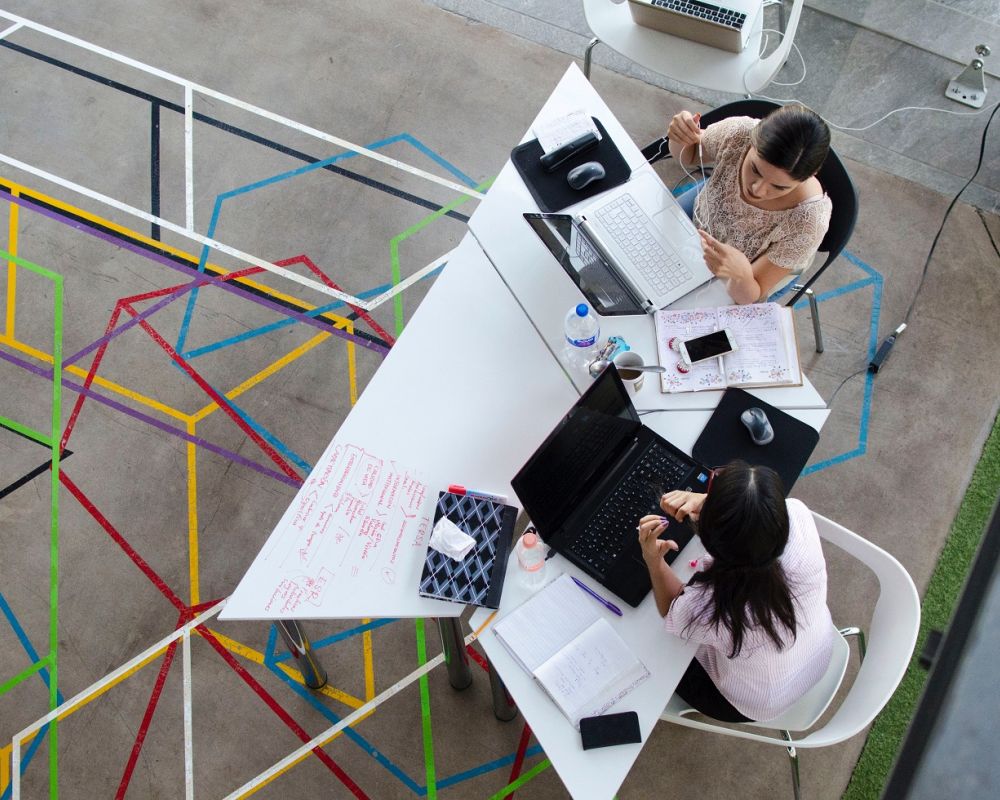7+ Ways to Improve Workplace Culture Through Design
It’s easy to write a mission statement. It’s even easier to create a set of brand values. Many businesses do this every day and call it a “workplace culture”. But what good is a value system if there isn’t anything in place to enact it? That’s where effective design can help.
With more workers than ever prioritising company culture and wellness over salary, developing a positive culture can help you attract and retain the best talent in your industry. Without a system in place to allow this organic work culture to manifest, you might find more and more of your team putting in minimal effort in projects, friendly interactions and more. What follows is a series of steps you can implement in your office fitout design to help you create a space where people want to work.
What is Workplace Culture?
Workplace culture encompasses the values, beliefs, and behaviours that define the identity of an organisation. It influences how employees interact, communicate, and collaborate, shaping the overall work environment and employee experience. A strong and positive workplace culture is essential for attracting and retaining top talent, driving innovation, and fostering a sense of belonging and purpose among employees.
When thinking of your work culture – is it peaceful, laid-back, stressful or even isolating? Is the majority of work done by individuals sitting at desks, or are a lot of projects done by groups sitting around a table? Many factors affect workplace culture that can massively influence the way work takes place in the office environment. While no workplace culture is objectively better than any other, it is good to keep an open mind and make changes if you see opportunities for improvement.

The Impact of Design on Workplace Culture
Design plays a pivotal role in shaping workplace culture by creating physical environments that reflect and reinforce organisational values and goals. Thoughtfully designed office spaces can facilitate communication, encourage collaboration, and inspire creativity, ultimately enhancing employee engagement and satisfaction. By incorporating design elements that prioritise comfort, flexibility, and wellness, businesses can cultivate a vibrant and inclusive workplace culture that drives success.
Keep in mind that while office design is extremely effective in creating a space for culture to thrive, its effects last through leadership. As a business owner, you also should take meaningful steps towards creating a space where employees feel included, valued, and appreciated.

7+ Ways to Improve Workplace Culture Through Design
1. Open and Collaborative Spaces
Open-plan layouts and communal areas promote spontaneous interactions and facilitate a culture of collaboration across teams. Through flexible furniture arrangements and breakout zones, individuals are encouraged to share ideas no matter their rank or hierarchy.
Outside of facilitating easier communication, open-plan offices are more cost-effective to run. Fewer private spaces mean that other commodities (e.g. lighting and plumbing) do not need to run throughout the entire fitout.
2. Add a Splash of Colour
Another thing to consider when designing an office space for a better work mentality is colour. Colour can have a huge impact on how we work and how we feel, impacting us on an almost subconscious level. It's the reason why so many companies use blue as a way to instil brand trust. When designing an office, consider how your team works. Are they talkative? Introspective? Focused? Experiment with colour psychology in different parts of your office and observe how your team interacts in these spaces.
For example, check out this family office fitout. As soon as visitors step inside the motif is clear. Blue sets the tone of the entire fitout with various blue hues making appearances along furniture, desks, art, and more. Without even knowing what type of business it is, you already get the feeling that this office works hard just as much as they play hard.
3. Purpose Built Rooms & Spaces
A new way of looking at the workplace is “activity-based” working, which has seen a lot of growth over recent years. Instead of individuals having their own set space to work in, different tasks are done in different areas. This could be a design room, a room for writing, a room for conversation, and a room for meetings. The opportunities are endless and can be customised to suit your business.
Although this is a great way of working it isn’t necessarily for everyone. Consultancies, graphic design companies and software houses could all benefit from this style of working as it allows groups of people working on similar parts of a project to use the same space which will, in turn, act to influence each other’s work for the better. If you do consider this style of work then it has to be a decision based on boosting productivity and not through popularity.
4. Consider Aesthetics
Fitout design choices may seem inconsequential to some. But when the right choices are made it can have a significant, measurable effect on the productivity, attitude and general morale of your office. An unconventionally shaped desk, a set of desks in a circle or an office pod all convey a different subtext around the type of work that is performed in the space. Natural or natural-like lighting also impacts feelings and emotions. Just like a spa or a nice hotel being in a beautifully designed space can put you in a positive mood, resulting in increased productivity throughout the day.
The more thought and planning that goes into an office fitout, the better the office culture will be. Of course, you’re running an office not an art gallery, but that doesn’t mean that aesthetics shouldn’t be a large part of your consideration and planning. When it comes to office fitouts, there’s no such thing as a one-size-fits-all design. There will be many factors that affect the overall layout of the office. Managerial style, type of office, culture and many other factors will have an impact. The best way of looking at it is to manipulate your office to suit you and your colleagues.
5. Prioritise Team Wellness Through Homely Design
Working from home during the pandemic gave many a sense of convenience. You can cook a fresh lunch instead of eating a cold pre-packed meal. You can rest on the couch during work breaks, or even walk your dog around the neighbourhood. For that reason, some companies are renovating their offices with more home-like elements. It’s not just an office, but a living space as well.
Some home features include showers (for those who may exercise before work), kitchenettes, bean bags, and other comfortable furniture. Kitchens are transformed into comfortable lounge areas promoting socialisation and stress relief during break times. Some larger office fitouts are now starting to include dedicated spaces for mindfulness and meditation.
Plants and greenery can reduce stress and improve mood. Strategic placement of low-maintenance plants can also instil a culture of positivity and optimism in the workplace.
Further Reading: How an Office Fitout Can Improve Your Health & Wellbeing
6. Branding and Identity
Infuse office design with elements of corporate branding and identity to reinforce organisational values and foster a sense of belonging among employees. Use branded signage, artwork, and colour schemes to create a cohesive and visually engaging environment that reflects the company's ethos.
Break rooms and game rooms are just as important as productivity spaces when it comes to maintaining morale, positivity, and ultimately happy employees. Employees are encouraged to take breaks and socialise with co-workers which in turn increases satisfaction and productivity.
7. Allow Room for Personalisation
Employees who have creative control over their office environment are 32% more productive. They’re also happier and healthier.
Office personalisation instils a sense of ownership and belonging, fostering motivation. Encourage employees to bring personal items like family photos, travel mementos, quirky desk accessories, or plants to create a homely atmosphere at their desks. In open office plans, offer options like dividers or screens for those seeking more privacy.
When employees make their workspaces unique to them, it becomes a reflection of their identity, contributing to overall workplace happiness. By acknowledging and supporting individuality, businesses can enhance employee engagement and well-being.
8. Design Around Who You Are (Not The Other Way Around)
Company culture comes in many forms. Some teams are familial and clandestine, others like to “move fast and break things”. Whatever culture your team imbues, you should design your collaboration spaces to reflect this overall ethos.
For example, a team with an Adhocracy culture will thrive well in spaces that promote experimentation. They are creators and require tools to record all of their many abstract ideas. Designing with this in mind, a simple whiteboard won’t do. You may need to bring in bigger elements (e.g. a whiteboard wall) along with relaxing furniture to promote creative brainstorming.
Remember that you don’t need to follow what’s trending. Design your office fitout around how your team likes to work and collaborate, not the other way around.

Designing for Success With Canopy Fitouts
Crack the code on workplace culture and help your employees thrive through thoughtful office design.
With serious consideration of office room layouts, furniture, aesthetics and employee workstyles, you can create a space where people look forward to doing their best work every day. And with our extensive experience in fitout builds and design, we can help you create your ideal office.
At Canopy, we are all about creating inspiring office fitouts. Our team of designers, architects, and builders will work with you to strike the perfect balance of form and function in your office. And with experience across 30+ industries, we know exactly what it takes to bring your workplace to life.
Speak to our team today and we’d be more than happy to give you advice on cost, budgets, requirements, and timeframes for your office or commercial fitout. Give us a call at 1800 434 868 or email info@canopyfitouts.com.au.


